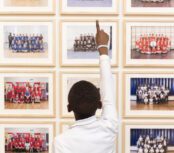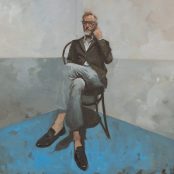Aug 31 - Sep 30
11:00 - 16:00
Location
Kristin Hjellegjerde Gallery
Despite the alarmist tone of the exhibition Kwadwo Asiedu’s work has an upbeat feel. Is wilting ever good? It signifies entropy surely. The collage-like pastiche feels of the paintings describe rock faces and other geological textural experiences that emphasise ‘new ways of seeing nature’ from things like a mollusc or heat itself. Which is to say, look at nature as a palette of exploitation, comprehension, and context but doing so from a non-anthropocentric view. A view which might be considered as romanticised as when some Western artist’s viewed all animals, lands and women as conquests. Here the romanticism is less about what water means to a mollusc or what sunsets and tidal forces mean for the struggling amoebic life and more about how abstract thought might manifest from other perspectives. In the artist’s words ‘Awe promotes curiosity when what we see is outside of our usual frame of reference, or when we see things that we cannot easily categorise or understand’ but perhaps awe is a matter of perspective. As minor beings in a universe of possibility our perspectives are insignificant but viewed from the emotionless order of this vast realm of physical properties, read as codes of manifestation, we might see the dramatic frustration of a limitless god annoyed at a malfunctioning roomba.
Kwadwo A Asiedu: As The World Wilts
Private View: Wednesday 30th August 2023, 6-8pm
Colours and textures shift like tectonic plates or cells moving beneath a magnifying glass – a world in motion. The Ghanaian, Mexican-born, Nigeria-based artist Kwadwo A. Asiedu uses his practice to explore nature at different scales, reflecting on humanity’s place within it and envisioning new symbiotic environments. For his first solo exhibition, As the world wilts, at Kristin Hjellegjerde Gallery in London, Asiedu presents a series of abstracted landscapes that each take an element of flora or fauna to imagine the life that surrounds it, ranging from the perspective of a mollusc to vast, jagged glacial forms.
Originally trained as a photographer, Asiedu uses his camera to capture the world around him. Over time he has built up an extensive archive of imagery that he uses to produce digital collages, combining seemingly disparate elements drawn from nature. These collages form fragmented visual maps that he then translates on to the canvas, harnessing the fluidity and texture of paint to create a sense of cohesion. Pearl-Essenced, for example, combines different textures and colour tones into a shimmering, undulating surface that imagines a mollusc looking out into its respective world. Here, the pearl which is usually considered by humans to be the most precious part of a clam is barely visible, a transparent orb floating in the lower left hand-side of the painting. ‘Through this piece I hope to bring about new ways of seeing nature and how we interact with it,’ says Asiedu. ‘Awe promotes curiosity when what we see is outside of our usual frame of reference, or when we see things that we cannot easily categorise or understand.’
Although Asiedu refers to his paintings as landscapes, they refer less to a specific geography than an emotional state. In this way, he draws on the Romantic concept of the sublime in which the subject, or viewer, is encouraged to participate emotionally and imaginatively with the natural world. The abstraction of the landscape allows this to happen more easily as the image is stripped of concrete details to appear volatile and expansive. This is perhaps most apparent in the paintings The Shepherd’s Pass and Thawed Evanescence, both of which conjure vast, unknowable worlds that elicit feelings of wonder as well as danger. While Thawed Evanescence refers to the melting of polar ice caps, with luminous channels of glacial water creating a free-flowing aqueous terrain, The Shepherd’s Pass leads us into a more barren landscape defined by steep, impenetrable rock faces. The latter environment was assembled from an amalgamation of photographs of goat carcasses, mushrooms sprouting on bark and a precious stone from Ethiopia, referencing sickness and decay as well as growth and rejuvenation.
The process of combining fragmented elements refers to our fractured relationship with nature but also to the different layers of time and the constant evolution of the natural world as it is forced to adapt to changing weather patterns, rising ocean levels and the loss of wildlife. ‘My practice is rooted in the understanding that nature will ultimately persist in contrast to our mortality,’ says Asiedu. ‘I do see my art as a form of environmental activism but in the sense that I hope the images I create can bring us closer to nature, engendering a sense of respect and admiration.’















